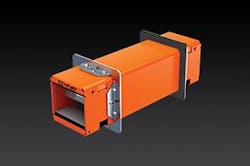UL declares EZ-Path firestop pathways to be maintenance-free
Specified Technologies Inc. (STI) recently announced that Underwriters Laboratories (UL) issued an evaluation report (Report Number UL ER14579-01) for the EZ-Path Fire-Rated Pathway. STI explained that the report “addresses many facets of building and safety code compliance in accordance with the International Building Code (IBC), International Fire Code (IFC), and NFPA 101 Life Safety Code (LSC).”
The IFS and LSC have specific requirements for maintaining fire protection features integrated into buildings, STI said. “The 2015 IFC states in Section 703.1 that elements, including firestops, shall be subject to annual inspection and repair by the owner,” the company noted. “The 2012 and 2015 LSC states in Section 4.6.12 that devices in fire-resistance rated construction shall be continuously maintained. To maintain compliance over time, firestop sleeves or devices that require an action to activate the sealing function (e.g. packing or fill materials or twist-closure) must be inspected and kept in good repair, thereby increasing the total cost of ownership and creating many headaches.”
According to STI, the third-party evaluation report affirms that EZ-Path is maintenance-free because it contains no moving parts and requires no independent action to provide the fire and smoke sealing function. Therefore, the company explained, it is always compliant. STI’s vice president of engineering, James P. Stahl Jr., CFPS, CDT, said, “This designation by UL confirms our positioning that EZ-Path Fire-Rated Pathways are the industry’s only maintenance-free cable pathway devices that eliminate downstream maintenance and repair activities, and possibly inspection, associated with other firestop sleeves.”
Specified Technologies specifically pointed to the physical environments in healthcare facilities, where maintenance-free cable pathways are of great significance “because access into concealed spaces may be more restricted due to infection control risk procedures.” Douglas S. Erickson, FASHE, CHFM is STI’s senior advisor for healthcare and former ASHE deputy executive director. He commented, “Eliminating the need to access, maintain, and therefore inspect, cable pathways in turn limits liability. Trips above ceilings or in shafts where potential pathogens can be disturbed and spread in the hospital increase the risks of contamination in areas where patients with immunocompromised systems are more susceptible to airborne infections. Since these devices never need maintenance, you will eliminate IT-related work that will likely upset clinical workflows, disrupt patient spaces, or disturb infectious particulates in concealed spaces.”
